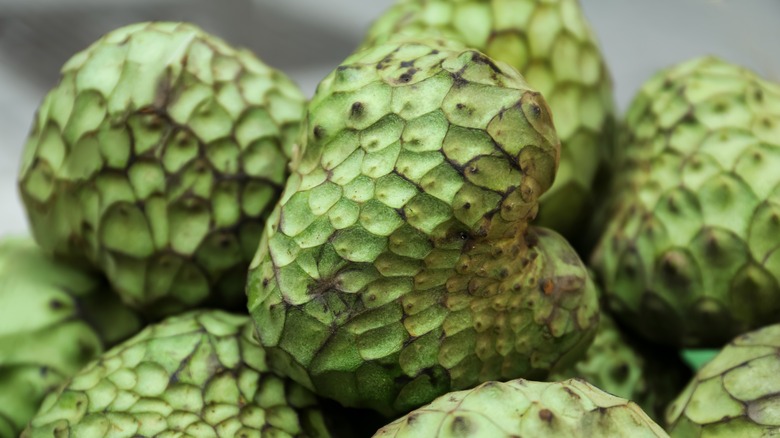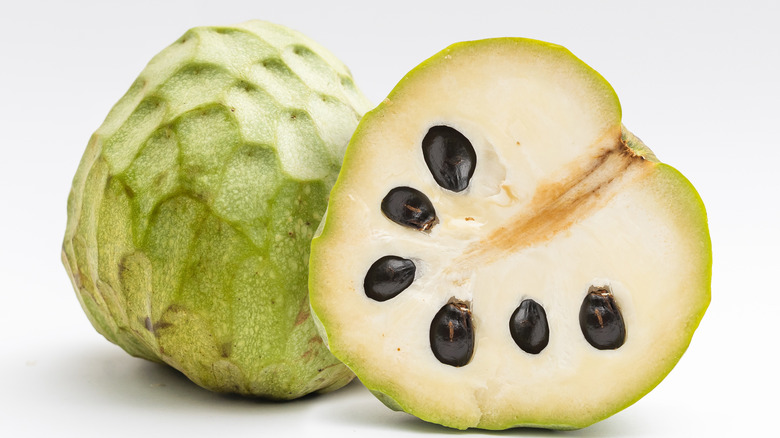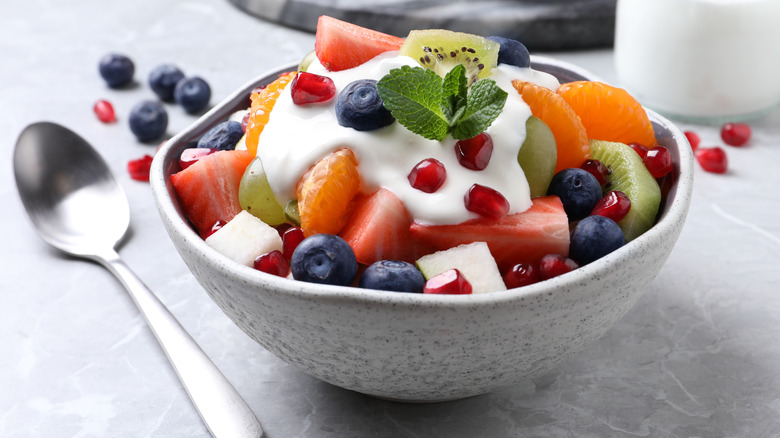What Is A Cherimoya, And How Do You Eat One?
One of the best feelings is cutting into a refreshingly lush tropical fruit on a hot summer day. While you may know and love mango, kiwi, and papaya, there's a lesser-known fruit you need to try: cherimoya.
Originating in the South American countries of Ecuador, Columbia, and Peru, cherimoya is grown on trees and picked prior to ripening off the vine. It grows in areas with tropical climates across the world and belongs to a family of tropical fruit called custard apple (though custard apple itself is a different fruit). Inside the round (sometimes heart-shaped) fruit with scaly green skin is a custardy, sweet flesh that has a texture similar to that of a silky jackfruit. Cherimoya tastes like a combination of several tropical fruit, including banana, papaya, mango, and peach, depending on who you ask. The creamy nature of the fruit has even been compared to tropical pastry cream or flan. And in addition to the fruit's deliciously succulent bite, it's high in antioxidants, including the eye-health-supporting carotenoid lutein, as well as vitamins such as B6.
In the United States, cherimoya is grown seasonally in California, Hawaii, and Florida. If you see cherimoya in stores or while in tropical regions, pick up one or two to try, or buy a bunch to use as a fruity addition to sweet and savory recipes alike.
Slice the fruit and scoop
You can tell cherimoya is ripe the same way you would with other fruits, such as avocados or mangoes. When the fruit is slightly soft to the touch, it's ready to eat. If it seems a bit too firm when you squeeze it, cherimoya can be left to sit on the counter top or fruit bowl for a day or two to soften.
Preparing the fruit is easy. To eat cherimoya, you just need a paring knife and a spoon. Use a knife to cut it lengthwise from the stem to the base of the fruit, or rip the fruit open with your hands (the peel isn't very thick). Then, scoop out the silky smooth white flesh with a spoon. Be sure to avoid and remove the shiny, hard black seeds, as those are toxic to consume.
Eat the fruit right away (it might be hard not to), or store the leftovers in the refrigerator in an airtight container or covered with plastic wrap. To prepare cherimoya for later use, cut it into pieces and place them on a baking sheet prepared with parchment paper, then freeze.
The many ways to enjoy cherimoya
Cherimoya is a versatile, refreshing fruit that can be enjoyed in an array of recipes. Eat it the same way you would eat ice cream, straight from the spoon or scooped into serving bowls and topped with homemade whipped cream. For an inventive take on an afternoon snack, cut up cherimoya and add the cubes to a fresh-cut tropical fruit salad recipe.
Cherimoya is also a great fruit to cook or bake with, and it allows for a lot of creativity in the kitchen. Use the juicy, smooth fruit as a sweet accent to savory dishes and snacks, such as mango salsa or shrimp ceviche recipes. For a refreshing drink, blend chunks of cherimoya into smoothies or cocktails.
And for breakfast on the go or a delectable dessert, simply mash up the fruit for use in baking tropical fruity muffins, cakes, or custard pies.


